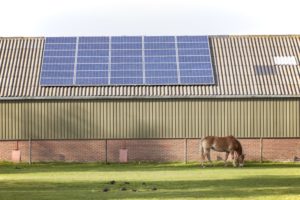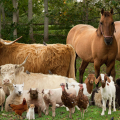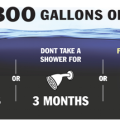 If you’re like most vegans, it was probably the humane treatment of animals that spurred your decision to quit animal products. But what you might not have realized is that you simultaneously dodged another bullet in the ethical eating dilemma: the environmental impact of your food.
If you’re like most vegans, it was probably the humane treatment of animals that spurred your decision to quit animal products. But what you might not have realized is that you simultaneously dodged another bullet in the ethical eating dilemma: the environmental impact of your food.
Meat and dairy farms have a pretty hefty “foodprint”—the measure of their carbon emissions from field to plate. Both generate large amounts of carbon dioxide, nitrous oxide, and methane, all greenhouse gases. Methane, in particular, has a heavy environmental toll. When allowed to seep freely into the air, it traps heat in the atmosphere, which contributes to global warming. And while we tend to focus on the harmful effects of CO2 when we discuss the greenhouse effect, methane’s chemical makeup is even more adept at holding heat, molecule for molecule. And since methane results from the breakdown of organic materials—like manure—it’s of particular concern where livestock is involved.
And there’s even more to consider—like your food’s water footprint. California’s drought brought attention to this issue like never before, with almonds and hummus both garnering some bad PR in the process. But there are worse water-hogs out there—and if you’re vegan, you’re avoiding the most malevolent. Beef, pork, and lamb all top the list of the most water-inefficient foods.
Still, avoiding meat doesn’t put you totally in the clear. Some of our favorite fruits, vegetables, and grains don’t rate so hot either when it comes to environmental impact. Here’s what to cut back on, and what you can use instead.
LENTILS
- It takes 704 gallons of water to get one pound of these legumes. To cut your water footprint here, use tofu instead as a protein source (soybeans only require around 254 gallons of water per pound). Or even rotate in a few recipes that call for dried soybeans!
POTATOES
- The combined growing, transportation, preparation, and cooking of potatoes lands them high on the list of CO2 offenders. Potatoes give off a hefty 2.9 kilograms of carbon dioxide for every kilogram of consumed food, which makes them the dirtiest vegetable out there. Skip your favorite spud and substitute other root vegetables, like rutabagas or parsnips. Just can’t give up that starchy, potato-y goodness? The way you prepare your potatoes counts. Flash cooking methods tend to let off less emissions than long stints in the oven, so go for the fries instead of the baked potato.
RICE
- At 299 gallons per pound of food, rice is one water-intensive crop. Fortunately, Oxfam International is currently working with farmers to disseminate a water-saving growing technique, known as System of Rice Intensification, which cuts the water footprint of this thirsty grain in half. For now, though, try substituting with barley, which scores better for water efficiency.
SUGAR
- Not only is sugar bad for your health, it’s also pretty bad for the environment, too. Unsustainable practices and poor management in the sugar industry have deeply harmed the Florida Everglades, poisoning precious marshlands with excessive fertilizers and runoff, which does a number on the area’s biodiversity. Here, too, ecologists are launching programs designed to target sugar’s sustainability concerns, most notably the Sustainable Sugarcane Initiative, whose aim is to improve production methods while increasing yield on sugar cane farms. In the meantime, you can even make your own sweetener by blending Medjool dates, water, and lemon juice. Date palms do best in dry, semiarid climates, so their fruit usually has a pretty low water footprint.
 Looking for something with a broader impact? Try one of these approaches:
Looking for something with a broader impact? Try one of these approaches:
- Buy Local Whenever You Can. One of the ways food racks up emissions is through travel. Off-season fruits and vegetables often have to be shipped in from warmer climates, which means a lot of fuel gets wasted in their transport. If you can’t always make it to the farmer’s market, see if there isn’t a local producer with a CSA box pickup or delivery service. At a bare minimum, try to avoid foods coming from New Zealand, South America, and Australia, since these travel longer distances overall.
- Support Farms that Use Renewable Energy. Thanks to the Rural Energy for America program, small agricultural producers can now receive a $20,000 grant to support the use of renewable energy their operations. In fact, savvy farmers can even capture and harvest excess methane as biogas, which can in turn be used to power barns and machines. There’s no comprehensive list right now of participants, however, so it’s best to research your favorite growers independently. Cornell University has put together a pretty good list of sustainable farms in the New York area.
- Avoid Genetically Modified Foods: GMOs are obviously a hot-button issue, but one of the consequences that’s often overlooked is the impact they have on the world’s biodiversity. Pest management can cause a chain reaction of suffering in local ecosystems, by eliminating necessary food sources for other animals. That’s why it’s important look for certified GMO-free foods wherever possible.
With a more thoughtful approach to our eating, we can work to improve our environment—not just for our own sake, but for every species on Earth, too!
Erin Vaughan is a blogger, gardener and aspiring homeowner. She currently resides in Austin, TX where she writes full time for Modernize, with the goal of empowering homeowners with the expert guidance and educational tools they need to take on big home projects with confidence.






No Comments